At the end of Navratri, the nine nights and 10-day religious festival, I prepare a traditional meal that is vegetarian and contains no onions or garlic. There are four components in this meal: Puri (fried, unleavened wheat bread), Sooji Ka Halwa (sweet farina porridge), Kale Chole (savory black chickpeas), and Aloo (potato stew).
This delicious meal makes up for the self-imposed restricted diet during the festival. My children all look forward to this meal as their reward for being good.
The savory, sour combination of Kale Chole with the sweet Halwa is amazing. The same goes for the crisp, hot Puris and the Aloo. These four dishes marry well in both texture and flavor.
I sometimes boil a double batch of Chole and freeze the extra, unseasoned Chole for salads or a Chaat. It’s a great time saver. Here is how I prepare my Kale Chole.
Hands-on time: 15 minutes
Cook time: 45-55 minutes
Yield: 5 cups
Kale chole
- *2 cups Kale Chole (dried black chickpeas), washed and soaked overnight
- *2-3 tablespoons Rye (black mustard seed)
- *1 tablespoon Jeera (cumin seed)
- *3/4 teaspoon Methi seeds (fenugreek seeds)
- *2 tablespoons coarsely ground Sooka Dhania (corriander seeds)
- *1 Bay leaf
- *1 1/2 tablespoons anardana powder (powdered dried pomegranate seeds)
- *2-3 tablespoons amchur
- *1 teaspoon kala namak (Indian black salt)
- *1 teaspoon Haldi (turmeric powder)
- *1 teaspoon Cayenne pepper – optional
- salt and black pepper to taste
- enough water to soak and then pressure cook the chickpeas
INSTRUCTIONS
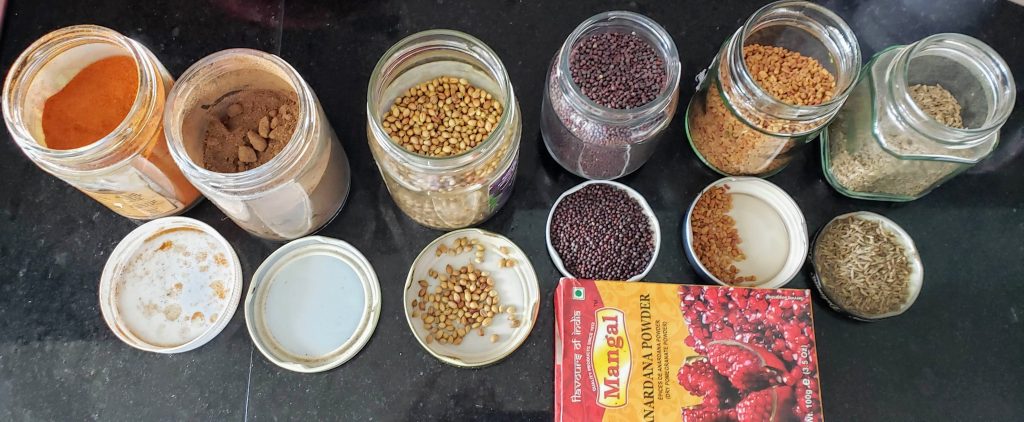
Cayenne pepper, Amchur powder, corriander seeds, mustard seeds, fenugreek seeds, cumin seeds, ground pomegranate seeds
1. Wash and soak the black chickpeas overnight. Make sure you cover them 2-inches of water because they will swell.
Here’s a shortcut, you can put the washed black chickpeas in a pressure cooker, cover them with 2-inches of water and cook them under pressure until the pressure cooker just comes up to the boil and begins to whistle. Turn off the flame and let them sit in the closed vessel for about 4 hours. At the end of 4 hours check to see if you have about 2-inches of water covering the reconstituted peas. Add more water if needed.
2. Rinse the soaked black chickpeas and place them in a pressure cooker. Cover the chickpeas with 2-inches of water and add the salt, bay leaf, and turmeric to the water and cook them under pressure for 40-45 minutes. Release the pressure by placing the pressure cooker under running water. Open the vessel and check to see if the chickpeas are done by squeezing one of them between your fingers. It should be soft but still able to hold its shape.
3. Place the uncovered vessel back on the burner and dry off all but 1/2 cup of water.
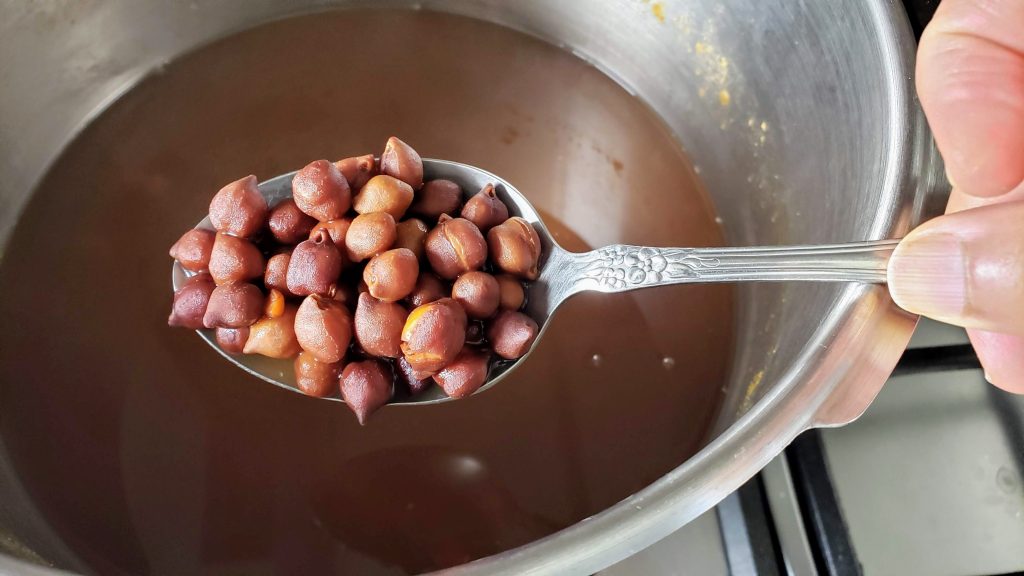
perfectly cooked 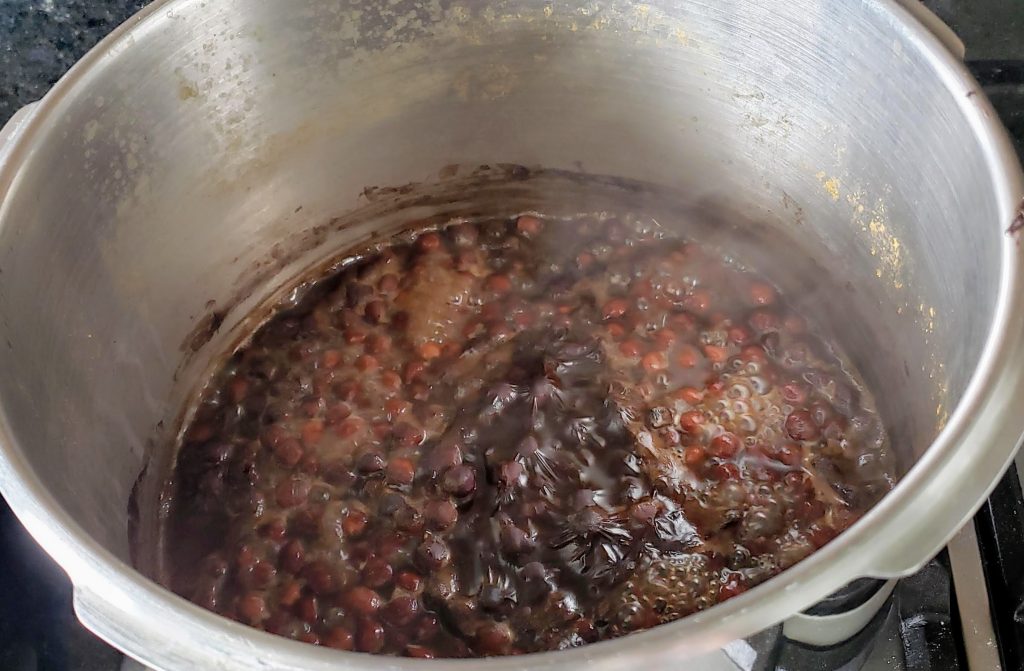
drying off excess liquid 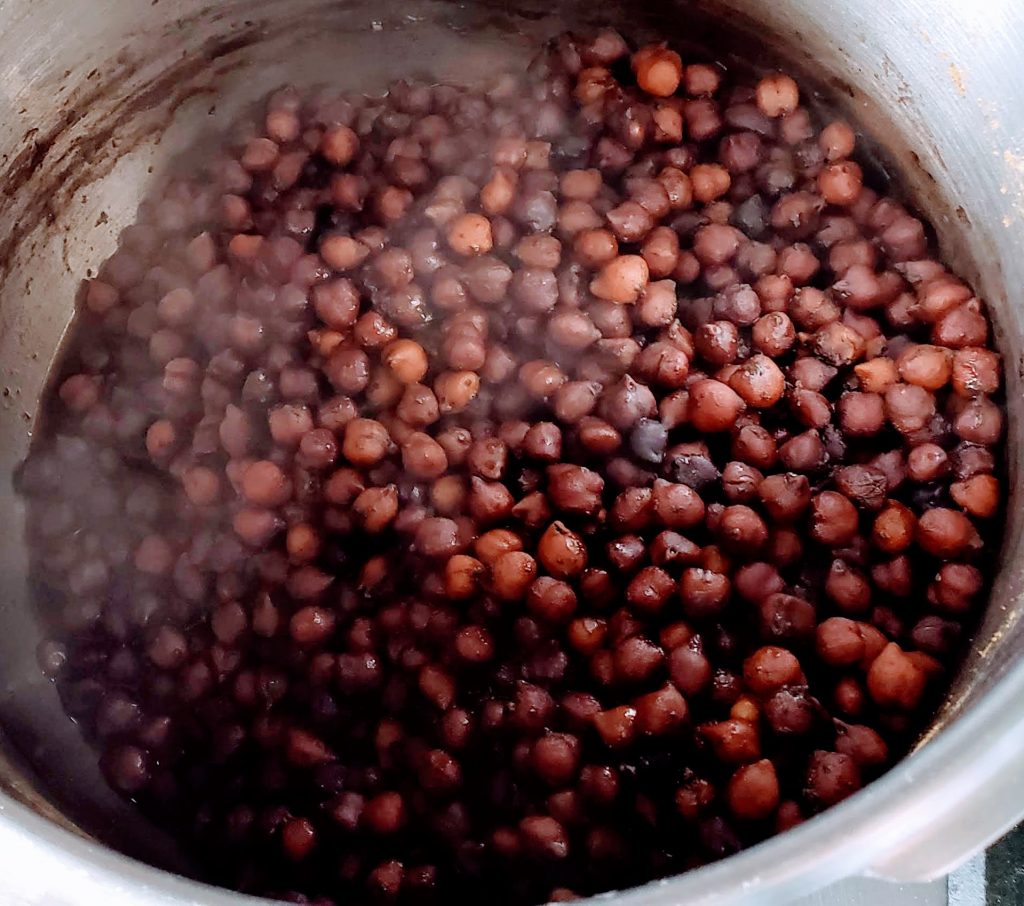
dry everything but 1/2 cup liquid
4. Heat 2 tablespoons of vegetable oil in a small saute pan or saucepan. Add the Rye (black mustard seed) and let it sizzle until it pops.
5. Add the Jeera (cumin seeds) and continue to cook until the cumin turns light golden brown.
6. Add the coarsely ground coriander and cayenne pepper and let them sizzle in the oil for another 30 seconds to a minute. Pour the oil roasted spices over the chickpeas.
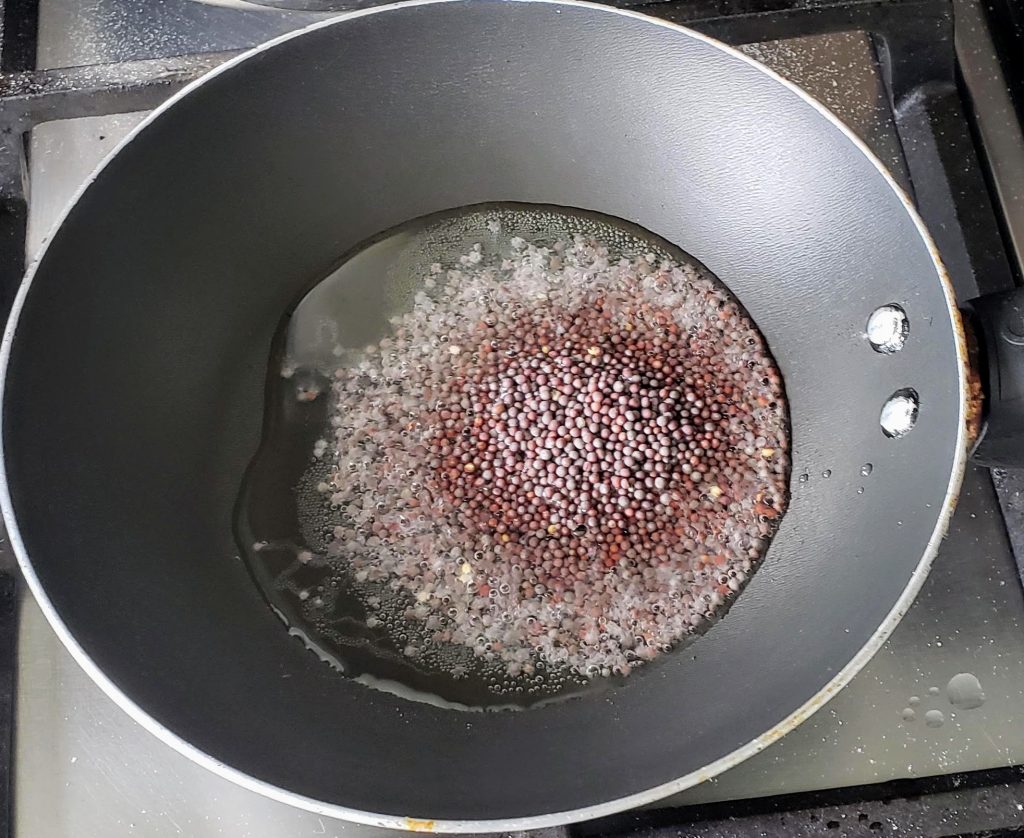
Mustard seeds popping 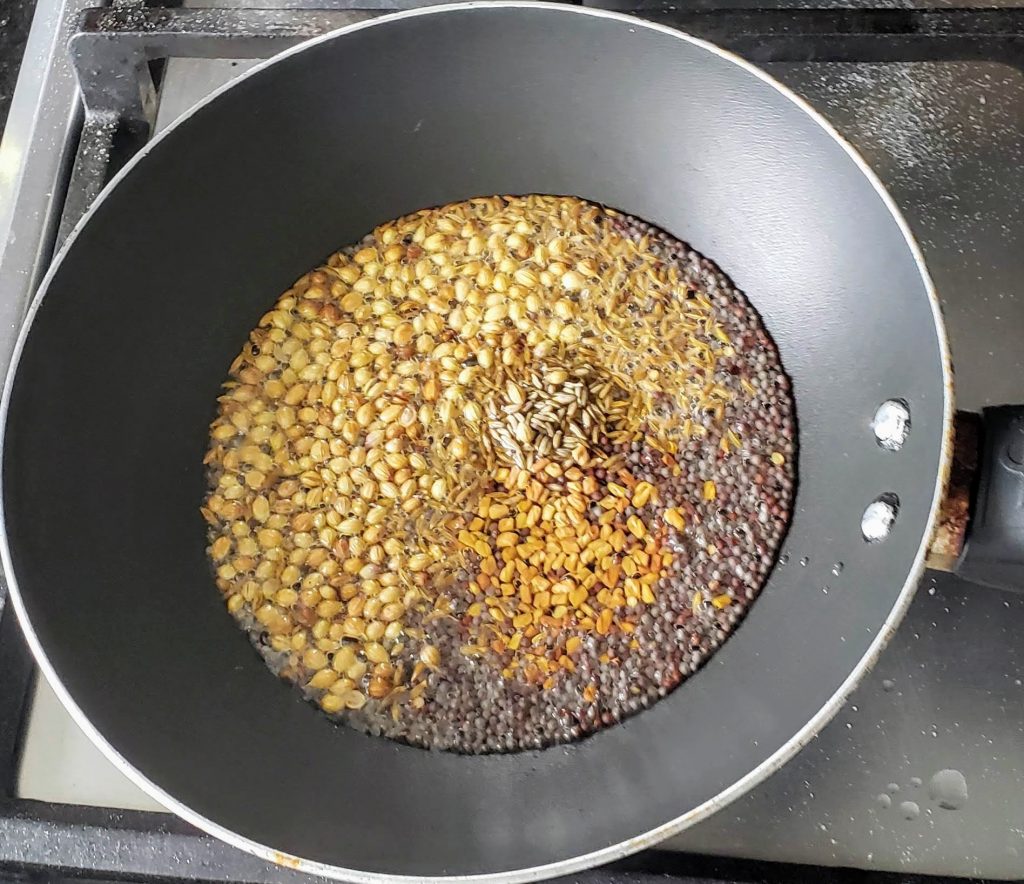
cumin, coriander, and fenugreek seeds 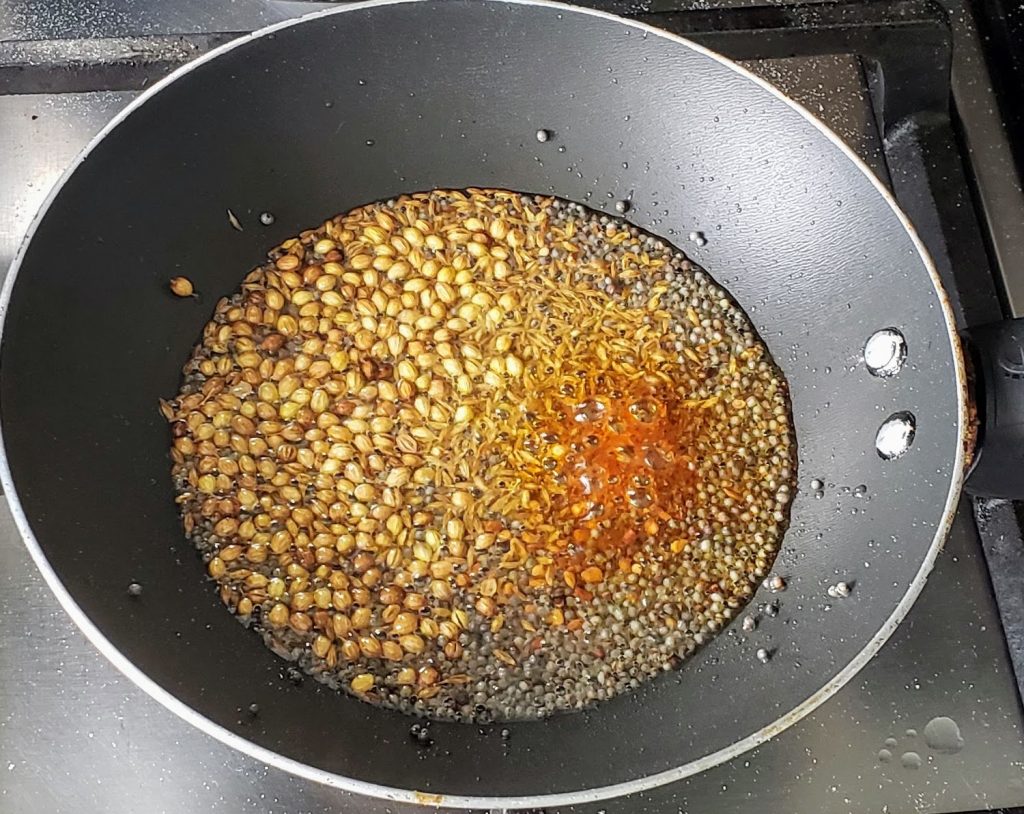
cayenne pepper last
7. Add the rest of the spices to the cooked black chickpeas.
8. Correct the salt. Serve hot.
Note:*These ingredients may be purchased at your local Indian grocer. For this reason, I have given you the name of the spice both in English and Hindi as that is the name (written phonetically in the English alphabet) you will find it under when you go shopping.
Spices impart specific flavors and aromas that enhance the overall flavor of the dish when used correctly. Moreover, they have a lot of health benefits. The list below specifies:
- The name of the spice;
- The flavor(s) it imparts;
- How and when it may be used; and, finally,
- It’s health benefits.
Amchur Powder (green mango powder) – Sour, slightly sweet, fruity.Used only in its powdered form. It is added to cooked food after turning the burner off. It is a large component in Chaat Masala, a condiment, sprinkled over Indian savory snacks like Papadi Chaat, Fruit and Potato Chaat, bean salads, etc.. It is used alone to impart a bright note to bland vegetarian dishes such as Lotus root, boiled black chickpeas, squash, potato, and yam dishes. Added to ground meat curry (Keema) to add a bright, sour note.Added to vegetable stuffing for Parathas (Indian stuffed flatbreads). Boosts digestion, contains vitamins A, C, D, and B6 which help your immune system. Amchur is also an antioxidant. It stimulates detoxification; helps in weight loss; and, is good for the heart.
Dried Pomegranate seeds (anardana) – Sour, fruity. If using it in the powdered form to season cooked food, add it after the burner has been turned off. Used whole or in powder form to season vegetable stuffings when making flatbreads (Parathas) or savory pastries (Samosas and Kachoris). Used to season boiled, dry bean dishes (kale chole) and potato and vegetable cutlets (Tikis). Made into candy and eaten. Natural aphrodisiac; lowers blood pressure; improves heart health; and, improves memory. It contains punicic acid, an Omega-5 fatty acid that helps fight breast cancer.
Haldi (turmeric powder) – Bitter and earthy. Turmeric is added to the oil after all the other spices during the cooking process. Used in powder form or the fresh, grated or minced form to season vegetable and meat dishes. Made into a pickle and eaten fresh. Boiled using fresh minced or powdered into a Tisane. Powdered form mixed with yogurt and black pepper and consumed. Added in powdered form to milk and consumed to combat sickness like cold/flu/throat ache or help reduce swelling in the body. Mixed with oil (coconut or any neutral tasting oil) into a paste as a wound dressing to prevent infection and reduce swelling; or, rubbed onto the face as a skin cleanser. The main active ingredient is curcumin. CURCUMIN IS POORLY ABSORBED BY THE BODY AND MUST BE CONSUMED WITH BLACK PEPPER TO INCREASE ITS ABSORPTION BY 2000%. If you are using a turmeric supplement, make sure it contains piperine (BioPerine) to help with curcumin absorption, otherwise, the curcumin will just pass through your body and not be absorbed. Curcumin is fat-soluble, so it is good to eat turmeric with a fatty meal. Curcumin is a powerful anti-inflammatory and anti-oxidant. Fights Alzheimer’s and depression by increasing a growth hormone (BDNF) that increases the growth of new neurons. It helps minimize the risk of heart disease. It helps fight cancer.
Jeera/Geera (cumin seeds) – Earthy, smoky. The whole form is added as one of the first spices when seasoning cooking oil. If using it in the powdered form to season cooked food, add it after the burner has been turned off. Used whole when flavoring cooking oil in vegetarian and meat dishes. The whole form is added as one of the first spices when seasoning cooking oil. Used as a powder either by itself or as part of Garam Masala after cooking for both vegetarian and meat dishes. Whole seeds are boiled in water to make a tisane to aid digestion (reduces gas), for weight loss, and relaxation. Rich in iron – it has 66g of iron per 100g which is five times the daily dose. Aids in digestion; improves blood cholesterol; promotes weight loss and fat reduction; and, helps promote sleep. It also helps with diabetes. It has both stimulating and calming effects. Improves cognitive function and helps prevent cognitive disorders such as dementia and Alzheimers. It also improves lactation.
Kala Namak (Indian Black Salt) – Salty, sour.Used in the same manner as table salt when cooking. It is used extensively as a condiment in cooking and in spice blends called Chaat Masala. Black salt has comparatively less sodium, it helps reduce bloating. In Ayurvedic medicine, it is considered to be a “cooling” spice. That is, it is calming and alkaline. Black salt is useful for curing depression problems. It helps to preserve both, melatonin and serotonin hormones, which are essential for a peaceful and unhindered sleep. Black salt is rich in potassium which helps to relax muscles and reduces muscle cramps. Potassium also helps to improve the absorption of many other minerals. Black Salt is recommended by many health professionals for its medicinal benefits as it is an antacid, anti-flatulent, antioxidant, digestive stimulant and a laxative. The American Society for Microbiology and European Pharmaceutical and Medical Research Journals have touted the benefits of this salt.
Kali Mirch (black pepper) – Sharp, spicy. Whole peppercorns can be added early on when using them to season cooking oil. However, the ground form is only used toward the end of cooking. Black pepper is used as a condiment and a food preservative. It is one of the components of Garam Masala and Chaat Masala. It is used whole to season doughs like Mathi (savory crip wafer). It is most often ground and used as a condiment in cooked foods. The ground form, when mixed with honey is used to relieve coughs and sore throats and improve breathing. Whole peppercorns are brewed into a tisane to effect the same benefits. For best results, don’t buy it preground as you’ll lose not only flavor but also many health benefits. BLACK PEPPER INCREASES THE BIOAVAILABILITY of certain other nutrients, especially, but not limited to CURCUMIN, WHICH IS THE ACTIVE INGREDIENT OF TURMERIC. It helps reduce swelling; it is a known antibacterial; it’s an anti-inflammatory; and, is high in antioxidants. It is a natural pain killer. In ancient times, it was used in conjunction with salt to preserve meat. It helps drain the sinuses.
Lal Mirch (cayenne pepper) – Spicy, sharp. Added directly after the dried whole spices either in its fresh or powdered form. When using its whole, dried form, add it in the middle when seasoning the oil. Minced and mixed in Chaat and bean salads or used whole, as a condiment or in a mixed vegetable salad. Hot peppers are often eaten as pickles. Powdered, whole dried, or fresh minced chili peppers are used in cooking and added directly after the dried spices to season the cooking oil., Hot peppers have anti-bacterial; anti-fungal; anti-inflammatory; and, anti-oxidant properties. It helps fight the cold/flu; reduces joint pain; improves metabolism; promotes weight loss; and, is rich in vitamins A, B6, C, K1, and minerals like potassium and copper.
Rye (mustard seed) – Whole spice tastes nutty; powdered form tastes sour and sharp. Used whole, it is one of the first spices to go into the oil. It must sizzle and pop in the oil to release its flavor. It is used to season oil in vegetarian cooking. It is used most often as a seasoning for pulses and potatoes. Some use it as a seasoning for yogurt in place of cumin. Its powdered form is an essential ingredient in making Kangi (a beet and carrot fermented drink). Rye is rich in selenium, a strong anti-inflammatory that helps reduce the severity of asthma attacks and certain symptoms of rheumatoid arthritis. Rye has strong antiseptic and antibacterial properties. It is rich in calcium, manganese, omega-3 fatty acids, iron, protein, and fiber.
Sooka Dhania (coriander seeds) – Smoky (if left whole) and sour (if ground). It is added in its split form to the cooking oil in the middle of the seasoning process. If using it in the powdered form to season cooked food, add it after the burner has been turned off. Used in powder form to season vegetable stuffings when making flatbreads (Parathas) or savory pastries (Samosas and Kachoris). Used roasted and coarsely ground to season cooking oil in vegetarian and meat gravies. Ground into a powder and used at the end to layer flavor in both vegetarian and meat dishes. It is one of the components of Garam Masala. Whole seeds are boiled into a tisane to relieve menstrual cramps during heavy flow. High in fiber and aids in bowel movement; promotes insulin production. Rich in copper, zinc, and iron and vitamins K, C, and B which are good for healthy skin and hair. It assists in weight loss and reduces body fat. FYI, plant coriander seeds to get fresh coriander plants.
Tej Patta (Bay laurel) – Earthy. Whole leaves are to the oil last, after the addition of other whole spices. Whole bay leaves are used to season sauces and gravies. They are generally removed before serving. It can be boiled into a tisane for reaping their health benefits. According to the Flushing hospital newsletter online, Bay leaves are a rich source of vitamin A, vitamin C, iron, potassium, calcium, and magnesium. Also, regular inclusion of bay leaves in meals promotes general health. They have been proven to be useful in the treatment of migraines.
Written by Anju Kapur of Anju’s Table. All content and images on this site are copyright protected. Please do not use any of my images without my permission. Should you wish to share this recipe on your site, please add a link to this post as the source.

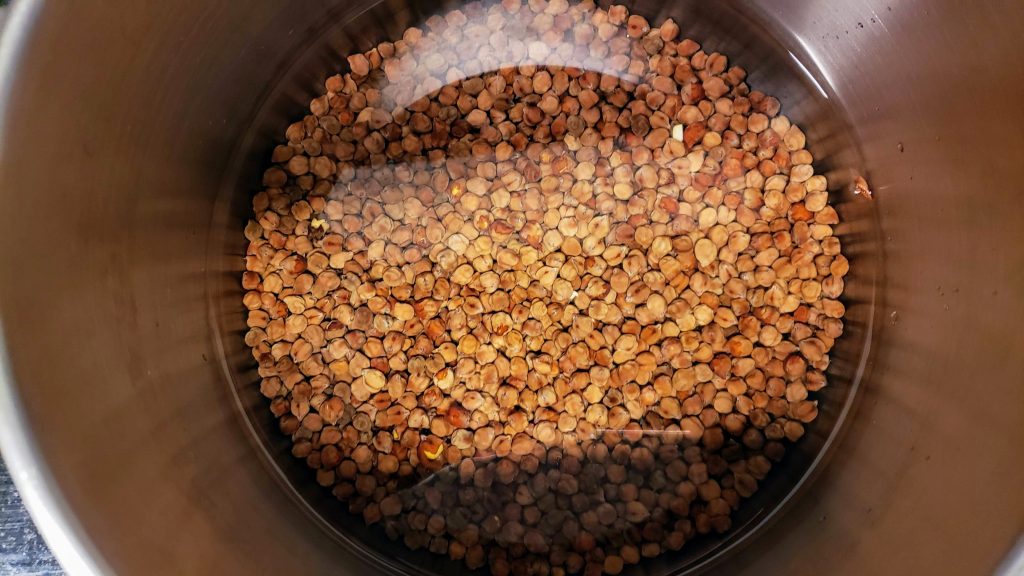

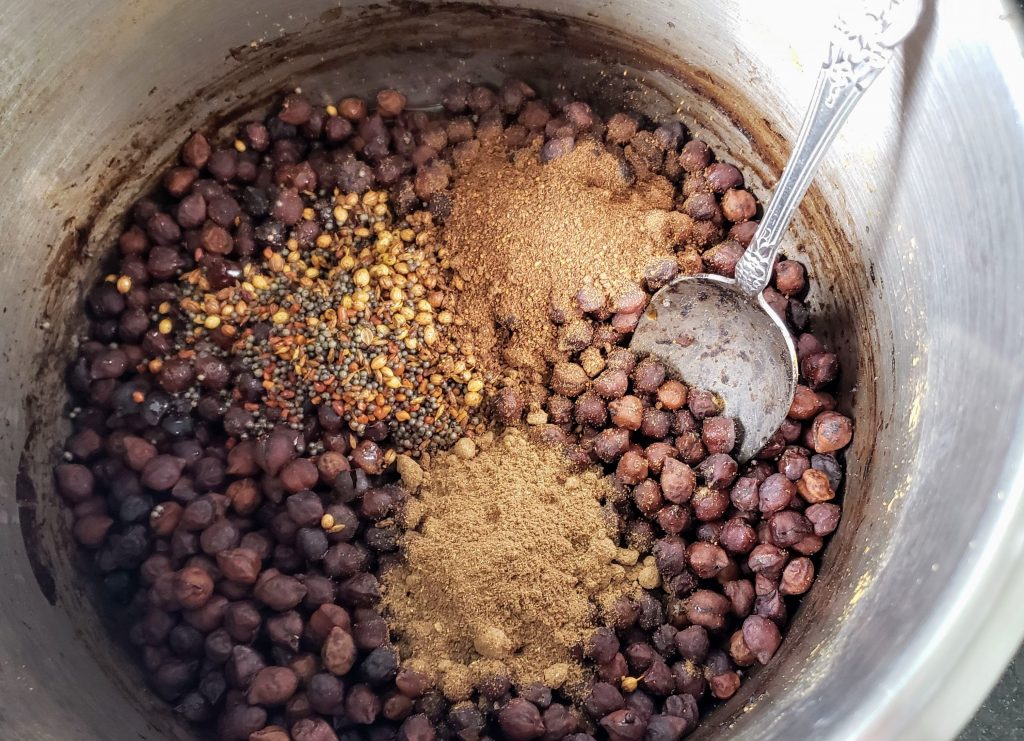

[…] cereal that’s much tastier than oatmeal or granola. It makes an excellent accompaniment for Kale Chole (Click on the link to see the recipe) as the contrasting textures and flavors marry […]
[…] our 9-night religious festival. They are one of the four components of the celebratory meal – Kale Chole, Sooji Ka Halwa, Aloo, and […]
[…] delicious, fast, and easy too. Inexplicably, I make it only for religious feasts alongside Puris, Kale Chole, and Sooji Ka […]